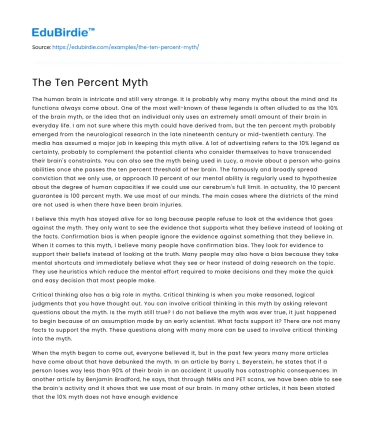The human brain is intricate and still very strange. It is probably why many myths about the mind and its functions always come about. One of the most well-known of these legends is often alluded to as the 10% of the brain myth, or the idea that an individual only uses an extremely small amount of their brain in everyday life. I am not sure where this myth could have derived from, but the ten percent myth probably emerged from the neurological research in the late nineteenth century or mid-twentieth century. The media has assumed a major job in keeping this myth alive. A lot of advertising refers to the 10% legend as certainty, probably to complement the potential clients who consider themselves to have transcended their brain's constraints. You can also see the myth being used in Lucy, a movie about a person who gains abilities once she passes the ten percent threshold of her brain. The famously and broadly spread conviction that we only use, or approach 10 percent of our mental ability is regularly used to hypothesize about the degree of human capacities if we could use our cerebrum's full limit. In actuality, the 10 percent guarantee is 100 percent myth. We use most of our minds. The main cases where the districts of the mind are not used is when there have been brain injuries.
I believe this myth has stayed alive for so long because people refuse to look at the evidence that goes against the myth. They only want to see the evidence that supports what they believe instead of looking at the facts. Confirmation bias is when people ignore the evidence against something that they believe in. When it comes to this myth, I believe many people have confirmation bias. They look for evidence to support their beliefs instead of looking at the truth. Many people may also have a bias because they take mental shortcuts and immediately believe what they see or hear instead of doing research on the topic. They use heuristics which reduce the mental effort required to make decisions and they make the quick and easy decision that most people make.
Save your time!
We can take care of your essay
- Proper editing and formatting
- Free revision, title page, and bibliography
- Flexible prices and money-back guarantee
Critical thinking also has a big role in myths. Critical thinking is when you make reasoned, logical judgments that you have thought out. You can involve critical thinking in this myth by asking relevant questions about the myth. Is the myth still true? I do not believe the myth was ever true, it just happened to begin because of an assumption made by an early scientist. What facts support it? There are not many facts to support the myth. These questions along with many more can be used to involve critical thinking into the myth.
When the myth began to come out, everyone believed it, but in the past few years many more articles have come about that have debunked the myth. In an article by Barry L. Beyerstein, he states that if a person loses way less than 90% of their brain in an accident it usually has catastrophic consequences. In another article by Benjamin Bradford, he says, that through fMRIs and PET scans, we have been able to see the brain’s activity and it shows that we use most of our brain. In many other articles, it has been stated that the 10% myth does not have enough evidence to support it, but more evidence that would go against it. In Robynne Boyd’s article, it states that John Henley said that over the course of a whole day we would use all 100 percent of our brain. This is correct because throughout the day we do so many tasks that activate different parts of our brains. Researching drinking coffee, writing a paper, and walking outside all activate a different part of your brain to help you complete these activities.
The 10% myth has been around for many years because the media continuously brings it up, with different movies and books inspired by the myth. Through critical thinking, we can ask questions about the myth and choose the thought-out answer over the quick and easy one that we would have chosen with confirmation bias. Critical thinking can also be used in many job fields, not just psychology.






 Stuck on your essay?
Stuck on your essay?

